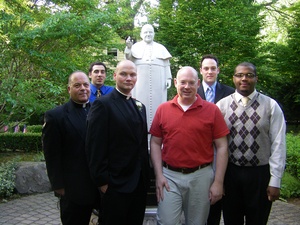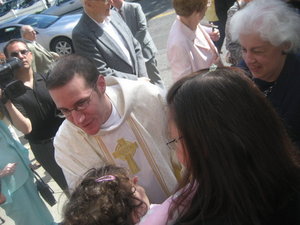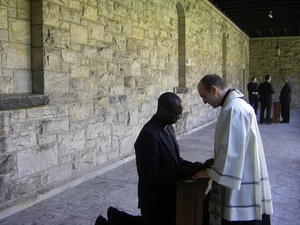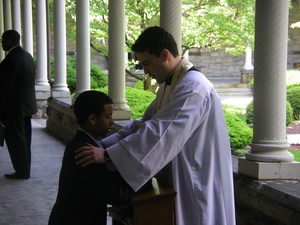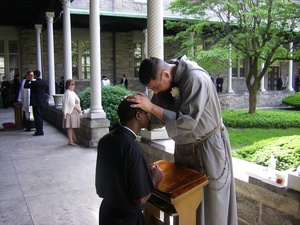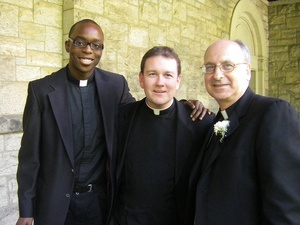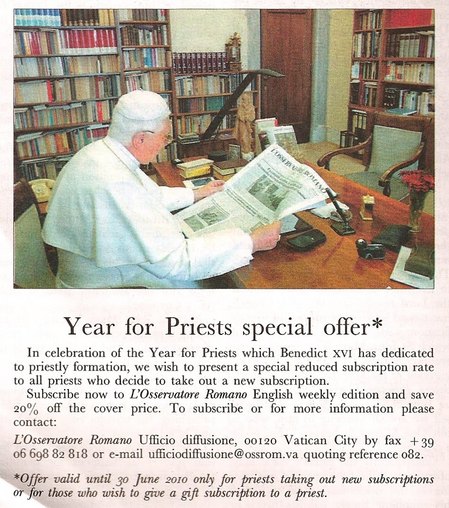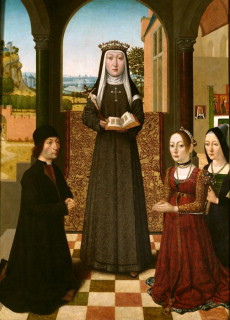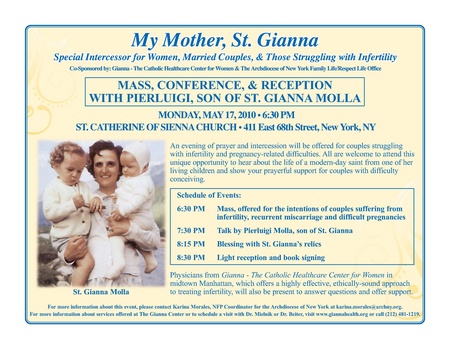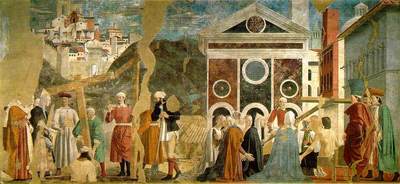Eternal Father, You inspired the Virgin Mary, mother of Your Son, to visit Elizabeth and to assist her in her need. Keep us open to the working of Your Spirit, and with Mary may we praise You for ever.
Sometimes it may seem to us that there is no purpose in our lives, that going day after day for years to this office or that school or factory is nothing else but waste and weariness. But it may be that God has sent us there because but for us Christ would not be there. If our being there means that Christ is there, that alone makes it worthwhile. ... It is not necessary at this stage of our contemplation to speak to others of the mystery of life growing in us. It is only necessary to give ourselves to that life, all that we are, to pray without ceasing, not by a continual effort to concentrate our minds but by a growing awareness that Christ is being formed in our lives from what we are. We must trust him for this; because it is not a time to see his face, we must possess him secretly and in darkness, as the earth possesses the seed. We must not try to force Christ's growth in us, but with a deep gratitude for the light burning secretly in our darkness, we must fold our concentrated love upon him like earth, surrounding, holding, and nourishing the seed. We must be swift to obey the winged impulses of his love, carrying him to wherever he longs to be: and those who recognize his presence will be stirred, like Elizabeth, with new life. They will know his presence, not by any special beauty or power shown by us, but in the way that the bud knows the presence of the light, by the unfolding in themselves, a putting forth of their own beauty.
Caryll Houselander (1901-1954), The Reed of God, p. 77
May 2010 Archives
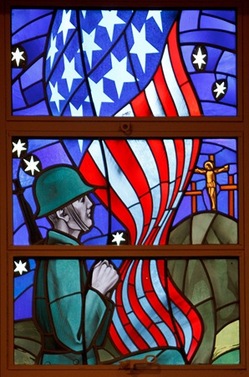 Let us pray for the women and men who gave their lives for freedom in the United States of America
Let us pray for the women and men who gave their lives for freedom in the United States of America
We pray.
Almighty and ever-living God, on this day we remember the sacrifices made for us by those who were willing to give their lives to ensure that our own would be spent in freedom. Let us never forget to pray, not only for the dead, but also for those still living and working in the cause of freedom around the world.
As we celebrate and enjoy this time, give comfort and grace to those men and women who have sacrificed so much for our sake. Saint Martin, Saint George and Saint Joan of Arc: pray for the protection of our soldiers in their efforts, and bring them home safely at the end of their duties wherever home may be. Amen.
 O my God, Trinity whom I adore; help me to forget myself entirely that I may be established in You as still and as peaceful as if my soul were already in eternity. May nothing trouble my peace or make me leave You, O my Unchanging One, but may each minute carry me further into the depths of Your mystery. Give peace to my soul; make it Your heaven, Your beloved dwelling and Your resting place. May I never leave You there alone but be wholly present, my faith wholly vigilant, wholly adoring, and wholly surrendered to Your creative Action.
O my God, Trinity whom I adore; help me to forget myself entirely that I may be established in You as still and as peaceful as if my soul were already in eternity. May nothing trouble my peace or make me leave You, O my Unchanging One, but may each minute carry me further into the depths of Your mystery. Give peace to my soul; make it Your heaven, Your beloved dwelling and Your resting place. May I never leave You there alone but be wholly present, my faith wholly vigilant, wholly adoring, and wholly surrendered to Your creative Action.
O my beloved Christ, crucified by love, I wish to be a bride for Your Heart; I wish to cover You with glory; I wish to love You...even unto death! But I feel my weakness, and I ask You to "clothe me with Yourself," to identify my soul with all the movements of Your Soul, to overwhelm me, to possess me, to substitute yourself for me that my life may be but a radiance of Your Life. Come into me as Adorer, as Restorer, as Savior.
O Eternal Word, Word of my God, I want to spend my life in listening to You, to become wholly teachable that I may learn all from You. Then, through all nights, all voids, all helplessness, I want to gaze on You always and remain in Your great light. O my beloved Star, so fascinate me that I may not withdraw from Your radiance.
O consuming Fire, Spirit of Love, "come upon me," and create in my soul a kind of incarnation of the Word: that I may be another humanity for Him in which He can renew His whole Mystery. And You, O Father, bend lovingly over Your poor little crature; "cover her with Your shadow," seeing in her only the "Beloved in whom You are well pleased."
O my Three, my All, my Beatitude, infinite Solitude, Immensity in which I lose myself, I surrender myself to You as Your prey. Bury Yourself in me that I may bury myself in You until I depart to contemplate in Your light the abyss of Your greatness.
(Blessed Elizabeth of the Trinity, 21 November 1904)
 Almighty everlasting God, who granted to Your servants, in the profession of the true Faith, to recognize the glory of the eternal Trinity and to adore Its Unity in the might of majesty: we beseech You; that, in the steadfastness of that same Faith, we may always be defended from all adversities.
Almighty everlasting God, who granted to Your servants, in the profession of the true Faith, to recognize the glory of the eternal Trinity and to adore Its Unity in the might of majesty: we beseech You; that, in the steadfastness of that same Faith, we may always be defended from all adversities.
What do we, as Catholics, the Church, believe about the Holy Trinity? Much, in fact. Here are three paragraphs from the Catechism of the Catholic Church:
"The mystery of the Most Holy Trinity is the central mystery of Christian faith and life. It is the mystery of God in himself. It is therefore the source of all the other mysteries of faith, the light that enlightens them. It is the most fundamental and essential teaching in the 'hierarchy of the truths of faith'. [GCD 43.] The whole history of salvation is identical with the history of the way and the means by which the one true God, Father, Son and Holy Spirit, reveals himself to men 'and reconciles and unites with himself those who turn away from sin'. [GCD 47.]" (CCC 234)
"The Trinity is a mystery of faith in the strict sense, one of the 'mysteries that are hidden in God, which can never be known unless they are revealed by God'. [Dei Filius 4: DS 3015.] To be sure, God has left traces of his Trinitarian being in his work of creation and in his Revelation throughout the Old Testament. But his inmost Being as Holy Trinity is a mystery that is inaccessible to reason alone or even to Israel's faith before the Incarnation of God's Son and the sending of the Holy Spirit." (CCC 237)
"The whole divine economy is the common work of the three divine persons. For as the Trinity has only one and the same natures so too does it have only one and the same operation: 'The Father, the Son and the Holy Spirit are not three principles of creation but one principle.' [Council of Florence (1442): DS 1331; cf. Council of Constantinople II (553): DS 421.] However, each divine person performs the common work according to his unique personal property. Thus the Church confesses, following the New Testament, 'one God and Father from whom all things are, and one Lord Jesus Christ, through whom all things are, and one Holy Spirit in whom all things are'. [Council of Constantinople II: DS 421.] It is above all the divine missions of the Son's Incarnation and the gift of the Holy Spirit that show forth the properties of the divine persons." (CCC 258)
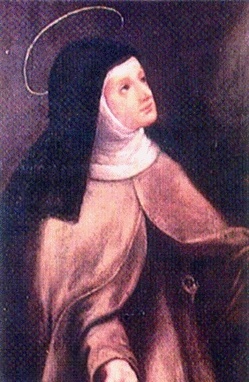
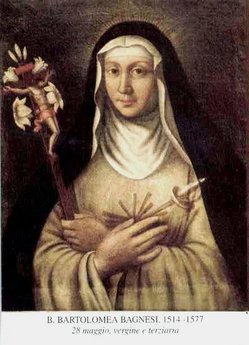 O God, in Blessed Mary Bartholomew you brought
together steadfastness in suffering and innocence of life as we endure many
trials may we be helped by your grace.
O God, in Blessed Mary Bartholomew you brought
together steadfastness in suffering and innocence of life as we endure many
trials may we be helped by your grace.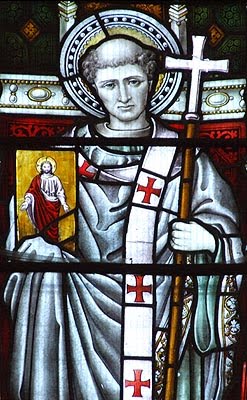

 One of the epitaphs of Saint Philip Neri's is:
One of the epitaphs of Saint Philip Neri's is:
"Philip Neri, learned and wise, by sharing the pranks of children himself became a child again."
Father Frederick Miller's excellent article ''Saint Philip Neri and the Priesthood'' gives a glimpse into this wonderful saint.
On a personal note, I went to Neri's tomb at the Chiesa Nuova (Rome) yesterday to offer a prayer for a friend, and myself, and found consolation.
Remember, ''To pray well requires the the whole man.''
Last week there was an extraordinary Mass of Saint Gianna and a talk by the saint's son at the Church and Priory of Saint Catherine of Siena (E. 68th St, NYC). I still find it amazing to say that a saint's son is talking about his mother, a saint of the Church. Dominican Brother Ignatius Perkins wrote a reflection on what he experienced and gave some helpful links to a story in the Catholic New York and the video on Currents TV. Having been there myself --though serving the Mass-- I am still in awe of the event because I think it truly was an encounter with Christ. Some many people came to meet Christ through the witness of Saint Gianna, the Mass and others. I wouldn't be surprised if several miracles result from this event.
The Church of Saint Catherine of Siena was packed with people (SRO) with stunning music and fine preaching. The presence of the staff of the Dominican Friars Healthcare Ministries and the Gianna Center was aslo a beautiful thing. The faithful, indeed, wrote their intentions for Saint Gianna's intercession and venerated relics of the saint.
Here's Brother Ignatius's review.
Here's the video for the Gianna Mass
 Rejoice to the full in the glory that is yours,
alleluia, and give thanks to God, alleluia, who called you to his kingdom,
alleluia, alleluia, alleluia.
Rejoice to the full in the glory that is yours,
alleluia, and give thanks to God, alleluia, who called you to his kingdom,
alleluia, alleluia, alleluia.Pope Benedict's homily for the Solemnity of Pentecost is quite insightful and spiritually challenging. Would that we all could be open to the call of the Spirit in truth and in action. Come Holy Spirit, come through Mary!
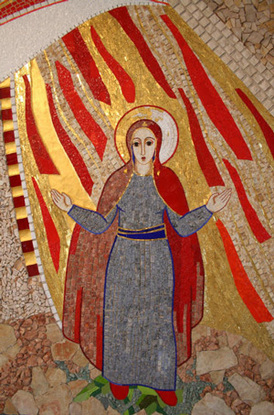 In the solemn celebration of Pentecost we are invited to profess our faith in the presence and in the action of the Holy Spirit and to invoke his outpouring upon us, upon the Church and upon the whole world. Let us make our own, and with special intensity, the Church's invocation: "Veni, Sancte Spiritus!"
In the solemn celebration of Pentecost we are invited to profess our faith in the presence and in the action of the Holy Spirit and to invoke his outpouring upon us, upon the Church and upon the whole world. Let us make our own, and with special intensity, the Church's invocation: "Veni, Sancte Spiritus!"
It is such a simple and immediate invocation, but also extraordinarily profound, which came first of all from the heart of Christ. The Spirit, in fact, is the gift that Jesus asked and continually asks of his Father for his friends; the first and principal gift that he obtained for us through his Resurrection and Ascension in to heaven.
Today's Gospel passage, which has the Last Supper as its context, speaks to us of this prayer of Christ. The Lord Jesus said to his disciples: "If you love me, follow my commandments; and I will pray to the Father and he will give you another Paraclete who will remain with you forever" (John 14:15-16).
Here the praying heart of Jesus is revealed to us, his filial and fraternal heart. This prayer reaches its apex and its fulfillment on the cross, where Christ's invocation is one with the total gift that he makes of himself, and thus his prayer becomes, so to speak, the very seal of his self-giving for love of the Father and humanity: Invocation and donation of the Spirit meet, they interpenetrate, they become one reality. "And I will pray to the Father and he will give you another Paraclete who will remain with you forever." In reality, Jesus' prayer -- that of the Last Supper and the prayer on the cross -- is a single prayer that continues even in heaven, where Christ sits at the right hand of the Father. Jesus, in fact, always lives his priesthood of intercession on behalf of the people of God and humanity and so prays for all of us, asking the Father for the gift of the Holy Spirit.
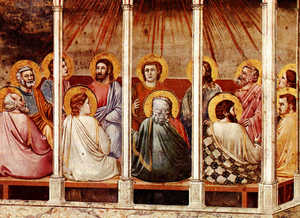 The account of Pentecost in the Acts of the Apostles -- we listened to it in the first reading (Acts 2:1-11) -- presents the "new course" of the work that God began with Christ's resurrection, a work that involves man, history and the cosmos. The Son of God, dead and risen and returned to the Father, now breathes with untold energy the divine breath upon humanity, the Holy Spirit. And what does this new and powerful self-communication of God produce? Where there are divisions and estrangement he creates unity and understanding. The Spirit triggers a process of reunification of the divided and dispersed parts of the human family; persons, often reduced to individuals in competition or in conflict with each other, reached by the Spirit of Christ, open themselves to the experience of communion, can involve them to such an extent as to make of them a new organism, a new subject: the Church. This is the effect of God's work: unity; thus unity is the sign of recognition, the "business card" of the Church in the course of her universal history. From the very beginning, from the day of Pentecost, she speaks all languages. The universal Church precedes the particular Churches, and the latter must always conform to the former according to a criterion of unity and universality. The Church never remains a prisoner within political, racial and cultural confines; she cannot be confused with states not with federations of states, because her unity is of a different type and aspires to transcend every human frontier.
The account of Pentecost in the Acts of the Apostles -- we listened to it in the first reading (Acts 2:1-11) -- presents the "new course" of the work that God began with Christ's resurrection, a work that involves man, history and the cosmos. The Son of God, dead and risen and returned to the Father, now breathes with untold energy the divine breath upon humanity, the Holy Spirit. And what does this new and powerful self-communication of God produce? Where there are divisions and estrangement he creates unity and understanding. The Spirit triggers a process of reunification of the divided and dispersed parts of the human family; persons, often reduced to individuals in competition or in conflict with each other, reached by the Spirit of Christ, open themselves to the experience of communion, can involve them to such an extent as to make of them a new organism, a new subject: the Church. This is the effect of God's work: unity; thus unity is the sign of recognition, the "business card" of the Church in the course of her universal history. From the very beginning, from the day of Pentecost, she speaks all languages. The universal Church precedes the particular Churches, and the latter must always conform to the former according to a criterion of unity and universality. The Church never remains a prisoner within political, racial and cultural confines; she cannot be confused with states not with federations of states, because her unity is of a different type and aspires to transcend every human frontier.
From this, dear brothers, there derives a practical criterion of discernment for Christian life: When a person or a community, limits itself to its own way of thinking and acting, it is a sign that it has distanced itself from the Holy Spirit. The path of Christians and of the particular Churches must always confront itself with the path of the one and catholic Church, and harmonize with it. This does not mean that the unity created by the Holy Spirit is a kind of homogenization. On the contrary, that is rather the model of Babel, that is, the imposition of a culture of unity that we could call "technological." The Bible, in fact, tells us (cf. Genesis 11:1-9) that in Babel everyone spoke the same language. At Pentecost, however, the Apostles speak different languages in such a way that everyone understands the message in his own tongue. The unity of the Spirit is manifested in the plurality of understanding. The Church is one and multiple by her nature, destined as she is to live among all nations, all peoples, and in the most diverse social contexts. She responds to her vocation to be a sign and instrument of unity of the human race (cf. Lumen Gentium, 1) only if she remains free from every state and every particular culture. Always and in every place the Church must truly be catholic and universal, the house of all in which each one can find a place.
The account of the Acts of the Apostles offers us another very concrete indication. The universality of the Church is expressed by the list of peoples according to the ancient tradition: "We are Parthians, Medes, Elamites ...," etc. One may note that St. Luke goes beyond the number 12, which always expresses a universality. He looks beyond the horizons of Asia and northwest Africa, and adds three other elements: the "Romans," that is, the western world; the "Jews and proselytes," encompass in a new way the unity between Israel and the world; and finally "Cretans and Arabs," who represent the West and the East, islands and land. This opening of horizons subsequently confirms the newness of Christ in the human space, in the history of the nations: The Holy Spirit involves men and peoples and, through them, it overcomes walls and barriers.
At Pentecost the Holy Spirit manifests himself as fire. His flame descended upon the assembled disciples, it was enkindled in them and gave them the new ardor of God. In this way what Jesus had previously said was realized: "I have come to cast fire upon the earth, and how I long that it already be burning!" (Luke 12:49). The Apostles, together with the faithful of different communities, carried this divine flame to the far corners of the earth; in this way they opened a path for humanity, a luminous path, and they worked with God, who wants to renew the face of the earth with his fire. How different this fire is from that of wars and bombs! How different is the fire of Christ, spread by the Church, compared with those lit by the dictators of every epoch, of last century too, who leave a scorched earth behind them. The fire of God, the fire of the Holy Spirit, is that of the bush that burned without being consumed (cf. Exodus 3:2). It is a flame that burns but does not destroy, that, in burning, brings forth the better and truer part of man, as in a fusion it makes his interior form emerge, his vocation to truth and to love.
A Father of the Church, Origen, in one of his homilies on Jeremiah, reports a saying attributed to Jesus, not contained in the sacred Scriptures but perhaps authentic, which he puts thus: "Whoever is near me, is near the fire" (Homilies on Jeremiah, L. I [III]). In Christ, in fact, there is the fullness of God, who in the Bible is compared to fire. We just observed that the flame of the Holy Spirit burns but does not destroy. And nevertheless it causes a transformation, and it must for this reason consume something in man, the waste that corrupts him and hinders his relations with God and neighbor.
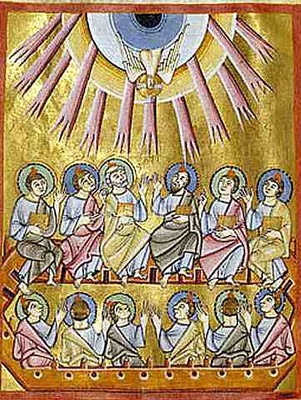 This effect of the divine fire, however, frightens us, we are afraid of being "burned," we prefer to stay just as we are. This is because our life is often formed according to the logic of having, of possessing and not the logic of self-giving. Many people believe in God and admire the person of Jesus Christ, but when they are asked to lose something of themselves, then they retreat, they are afraid of the demands of faith. There is the fear of giving up something nice to which we are attached; the fear that following Christ deprives us of freedom, of certain experiences, of a part of ourselves. On one hand, we want to be with Jesus, follow him closely, and, on the other hand, we are afraid of the consequences that this brings with it.
This effect of the divine fire, however, frightens us, we are afraid of being "burned," we prefer to stay just as we are. This is because our life is often formed according to the logic of having, of possessing and not the logic of self-giving. Many people believe in God and admire the person of Jesus Christ, but when they are asked to lose something of themselves, then they retreat, they are afraid of the demands of faith. There is the fear of giving up something nice to which we are attached; the fear that following Christ deprives us of freedom, of certain experiences, of a part of ourselves. On one hand, we want to be with Jesus, follow him closely, and, on the other hand, we are afraid of the consequences that this brings with it.
Dear brothers and sisters, we always need to hear the Lord Jesus tell us what he often repeated to his friends: "Be not afraid." Like Simon Peter and the others we must allow his presence and his grace to transform our heart, which is always subject to human weakness. We must know how to recognize that losing something, indeed, losing ourselves for the true God, the God of love and of life, is in reality gaining ourselves, finding ourselves more fully. Whoever entrusts himself to Jesus already experiences in this life peace and joy of heart, which the world cannot give, and it cannot even take it away once God has given it to us.
So it is worthwhile to let ourselves be touched by the fire of the Holy Spirit! The suffering that it causes us is necessary for our transformation. It is the reality of the cross: It is not for nothing that in the language of Jesus "fire" is above all a representation of the cross, without which Christianity does not exist.
Thus enlightened and comforted by these words of life, let us lift up our invocation: Come, Holy Spirit! Enkindle in us the fire of your love! We know that this is a bold prayer, with which we ask to be touched by the flame of God; but we know above all that this flame -- and only it -- has the power to save us. We do not want, in defending our life, to lose the eternal life that God wants to give us. We need the fire of the Holy Spirit, because only Love redeems. Amen.
![]() On May 9, 1897, Pope Leo XIII issued the first Encyclical Letter on the Holy Spirit. Of course from the days of the Acts of the Apostles the role of the Holy Spirit has been clearly taught.
On May 9, 1897, Pope Leo XIII issued the first Encyclical Letter on the Holy Spirit. Of course from the days of the Acts of the Apostles the role of the Holy Spirit has been clearly taught.
Pope Leo XIII actually reminded the modern world of the question Saint Paul brought up in Acts 19:2 when he asked some disciples at Ephesus, "did you receive the Holy Spirit when you became believers?" They replied "No, we have not even heard that there is a Holy Spirit." Pope Leo XIII went on to remind pastors and those with care of souls that they "should remember that it is their duty to instruct their people more diligently and more fully about the Holy Spirit."
Saint Benedict also clearly saw the importance of the Holy Spirit in his Rule for Monasteries. At the end of Chapter 7 on Humility, Saint Benedict wrote:
Having, therefore, ascended all these degrees of humility, the monk will presently arrive at that love of God, which being perfect, casts out fear (1 Jn 4:18). In virtue of this love all things which at first he observed not without fear, he will now begin to keep without any effort, and as it were, naturally by force of habit, no longer from the fear of hell, but from the love of Christ, from the very habit of good and the pleasure in virtue. May the Lord be pleased to manifest all this by His Holy Spirit in His laborer now cleansed from vice and sin.
In his Chapter 49 on Lent, Saint Benedict bids us: "During these days, therefore, let us add something to the usual amount of our service, special prayers, abstinence from food and drink, that each one offer to God "with the joy of the Holy Spirit" (1 Thes 1:6).
In his Encyclical on the Holy Spirit, Pope John Paul II referred to Saint Thomas Aquinas' Summa Theologica when he said:
Man's intimate relationship with God in the Holy Spirit also enables him to understand himself, his own humanity, in a new way. Thus that image and likeness of God which man is from his very beginning is fully realized.
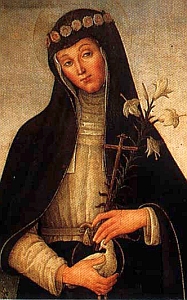 God of all mercy, you made Blessed Columba shine forth
by the innocence of her life and by her zeal for peace. By the
help of her teaching may we live together in unity and
serve you with pure minds.
God of all mercy, you made Blessed Columba shine forth
by the innocence of her life and by her zeal for peace. By the
help of her teaching may we live together in unity and
serve you with pure minds.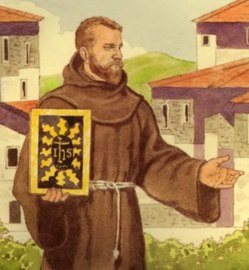 May my mouth speak the praise of the Lord, and may all flesh bless his holy name forever and ever, alleluia.
May my mouth speak the praise of the Lord, and may all flesh bless his holy name forever and ever, alleluia. Yesterday morning the founders, benefactors and friends of The Gianna Healthcare Center for Women joined Archbishop Timothy Dolan in dedicating and blessing the Center at 15 East 40th Street. We were joined by Saint Gianna's son, Pierluigi Molla.
Yesterday morning the founders, benefactors and friends of The Gianna Healthcare Center for Women joined Archbishop Timothy Dolan in dedicating and blessing the Center at 15 East 40th Street. We were joined by Saint Gianna's son, Pierluigi Molla.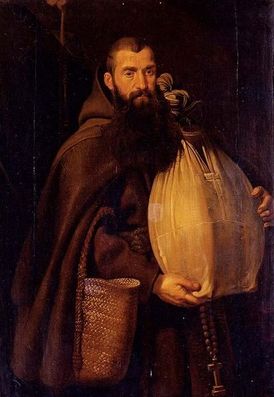 With joy thanks to God the Father who made us worthy to share the lot of the saints in light, alleluia.
With joy thanks to God the Father who made us worthy to share the lot of the saints in light, alleluia. Today, I had the distinct privilege to attend the rabbinical ordination of a colleague of mine. Gideon and I worked with the inter-seminary dialogue of the New York Seminaries, and so being present for a friend's ordination was meaningful and educative (since until now I had never been to a rabbinical ordination).
Today, I had the distinct privilege to attend the rabbinical ordination of a colleague of mine. Gideon and I worked with the inter-seminary dialogue of the New York Seminaries, and so being present for a friend's ordination was meaningful and educative (since until now I had never been to a rabbinical ordination). The archbishop met with the newly ordained today made gave them their new assignments as priests of the Archdiocese of New York:

Fr. James Ferreira: St. Teresa, Staten Island
Fr. George LaGrutta: St. Mary, Port Jervis
Fr. Steven Markantonis: St. Philip Neri, Bronx
Fr. Fredy Patino: St. Peter, Haverstraw
Fr. Tom Roslak: St. Augustine, New City
Fr. Enrique Salvo: St. Elizabeth of Hungary, Washington
Heights
Fr. Daniel Tuite: St. Patrick, Yorktown Heights
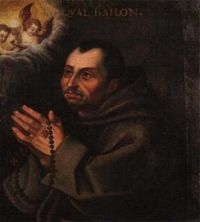 Lord God, You adorned Saint Paschal with wondrous love for the sacred mysteries of the body and blood of Your Son. Grant that we may derive the same spiritual riches from this divine banquet that he received.
Lord God, You adorned Saint Paschal with wondrous love for the sacred mysteries of the body and blood of Your Son. Grant that we may derive the same spiritual riches from this divine banquet that he received. Today was a glorious day! Besides the picture perfect day it was a perfect day to celebrate Mass for the first time by the recently ordained. A few seminarians and I had the privilege to be a part of the "First Mass festivities" of Father Thomas A. Roslak at the Church of the Holy Rosary, Staten Island, NY.
Today was a glorious day! Besides the picture perfect day it was a perfect day to celebrate Mass for the first time by the recently ordained. A few seminarians and I had the privilege to be a part of the "First Mass festivities" of Father Thomas A. Roslak at the Church of the Holy Rosary, Staten Island, NY.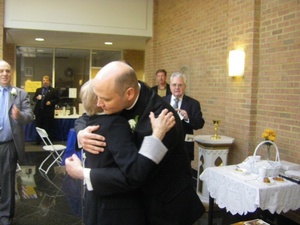
Jesuit Father James McCann has been named Rector of the
Pontifical Oriental Institute by Pope Benedict XVI. Father McCann will assume
his duties in Rome in September of 2010. His academic and ecclesial
administration coupled with his expertise in Eastern churches and society (the
focus of the Pontifical Oriental Institute) makes this appointment easy to
understand why he's a good choice. He'll be fresh air to the Oriental Institute
like his immediate predecessor did prior to be named an archbishop-secretary
for the Vatican office for Eastern churches last year.
The Pontifical Oriental Institute was founded by Pope Benedict XV in 1917 as a center for higher studies in Eastern Christianity.
Read Father McCann's bio here: New PIO Rector.pdf

Today in Rome members of the various Catholic lay ecclesial movements like Focolare, Sant'Egidio, Catholic Action and Communion and Liberation are gathering in Rome as a sign of prayerful solidarity at the Regina Coeli address of the Pope in Saint Peter's Square. Indeed, in a sign of friendship and obedience to the Successor of Saint Peter, Pope Benedict XVI. And as a sign of this worldwide communion with the Pope, members of Communion and Liberation are gathering in cities around the world in prayer for the Pope and the Church.
According to news about the event, about 150,000 people flooded Saint Peter's Square. The Pope said that he was comforted by the "beautiful and spontaneous show of faith and solidarity."
Here in New York, for example, CL is attending the Mass at Saint Patrick's Cathedral with Archbishop Timothy Dolan and will pray the rosary together.
To understand these pious and fraternal gestures of CL, here are some thoughts of Monsignor Luigi Giussani that may give a fuller appreciation of the companionship of faith and brotherhood we all share.
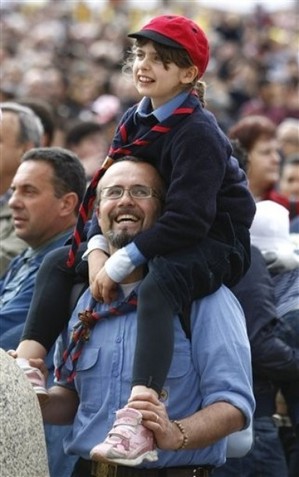
Christianity is an irreducible event, an objective presence that desires to reach man; until the very end, it means to be a provocation to him, and to offer a judgment of him. Jesus said to the Apostles after his Resurrection, "Behold, I am with you always, even to the end of the world" (Mt 28:20).
Christianity will have a dramatic and decisive bearing on man's life only if it is understood in accordance with its originality and its factual density, which, two thousand years ago, had the form of a single man. Yet even when He was still living, he also had the face of people whom he had brought together, and then sent out two by two, to do what He had been doing, and what he had told them to do; they came back together and returned to him. Later, united as one, this people went out to the entire known world to present that Fact. The face of that single man today is the unity of believers, who are the sign of him in the world, or as Saint Paul says, who are his Body, his mysterious Body - also called "the people of God" - guided and guaranteed by a living person, the Bishop of Rome.
If the Christian fact is not recognized and grasped in its proper originality, it becomes nothing more than a ponderous occasion for all sorts of interpretations and opinions, or perhaps even for works; but then it lies alongside of or more often subordinate to all of life's other promptings.
(Religious Awareness in Modern Man, Communio, vol. XXV, n.1, Spring 1998, pp. 134-135)
The supreme authority is the one in which we find the meaning of all our experience. Jesus Christ is this supreme authority, and it is His Spirit who makes us understand this, opens us up to faith in Him and His person. "Just as the Father has sent me so do I send you." (See John 20:21) The apostles and their successors (the Pope and the bishops) constitute, in history, the living continuation of the authority who is Christ. In their dynamic succession in history and their multiplication throughout the world, Christ's mystery is proposed ceaselessly, clarified without errors, defended without compromise. Therefore, they constitute the place, like a reliable and effervescent spring, where humanity can draw on the true meaning of its own existence, probing ever deeper. What genius is to the cry of human need, what prophecy is to our cry of expectancy, so the apostles and their successors are to announcing the response. But just as the true answer is always perfectly specific and concrete with respect to the expectancy which is inevitably vague and subject to illusions - so are they, like an absolute and reliable rock, infallible: "You are Peter and on this rock I shall build my Church." (Matthew 16:17ff.)

Their authority not only constitutes the sure criterion for that vision of the universe and history that alone explains their (i.e., the universe's and history's) meaning; it is also vital - it steadfastly stimulates a true culture and persistently points to a total vision. It inexorably condemns any exaltation of the particular and idealization of the contingent; that is, it condemns all error and idolatry. The authority of the Pope and bishops, therefore, is the ultimate guide on the pilgrimage towards a genuine sharing of our lives [convivenza], towards a true civilization.
Where that authority is not vital and vigilant, or where it is under attack, the human pathway becomes complicated, ambiguous, and unstable; it veers towards disaster, even when on the exterior it seems powerful, flourishing, and astute, as is the case today. Where that authority is active and respected, the historic pilgrimage is confidently renewed with serenity; it is deep, genuinely human, even when the expressive methods and dynamics of sharing lives are roughshod and difficult.
Still today it is the gift of the Spirit that allows us to discover the profound meaning of Ecclesiastical Authority as a supreme directive on the human path. Here is the origin of that ultimate abandonment and of that conscious obedience to it - this is why it is not the locus of the Law but of Love. One cannot understand the experience of that definitive devotion that binds the "faithful" to Authority without taking into consideration the influence of the Spirit, and that devotion often affirms itself on the Cross of a mortification of the drive of our own genius or our plans for life.
(The Journey to Truth Is an Experience, Montreal:
McGill-Queen's University Press 2006, pp. 73-75)
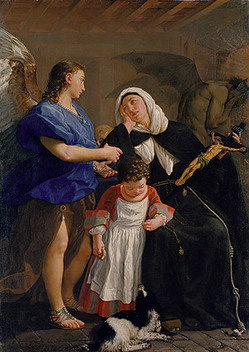 Has God forgotten pity? Does he in his anger withold his compassion? This is my sorrow that the right hand of the Most High is changed, alleluia.
Has God forgotten pity? Does he in his anger withold his compassion? This is my sorrow that the right hand of the Most High is changed, alleluia.
Heavenly Father, You take no pleasure in the death of the sinner but rather in the sinner's conversion that he may live. As You mercifully drew Your servant Margaret from the path of damnation to the path of salvation, grant that we may serve You with pure hearts.
Read the story of this 13th century Third Order Franciscan penitent, Saint Margaret of Cortona, who sought to live in communion with Jesus, her Lord.
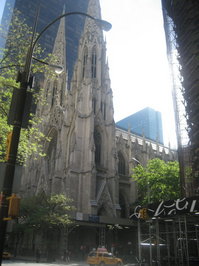
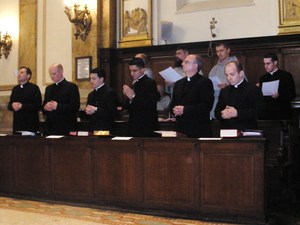 The Church asks those who are to be ordained and those who take an office of leadership to take an Oath of Fidelity. Pope John Paul II outlined the Church's expectations her ministers in a 1998 motu proprio Ad Tuendam Fidem, and concretely expressed in the "Profession of Faith and The Oath of Fidelity on Assuming An Office to be Exercised in the Name of the Church."
The Church asks those who are to be ordained and those who take an office of leadership to take an Oath of Fidelity. Pope John Paul II outlined the Church's expectations her ministers in a 1998 motu proprio Ad Tuendam Fidem, and concretely expressed in the "Profession of Faith and The Oath of Fidelity on Assuming An Office to be Exercised in the Name of the Church."
Cardinal Joseph Ratzinger's commentary notes that the Church's profession of faith has been received by the faithful, ordained and laity, as a ![P5130045[1].JPG](http://communio.stblogs.org/assets_c/2010/05/P5130045[1]-thumb-300x225-6459.jpg) line of continuity of what is authentically believed about the Blessed Trinity and the Church's share in the life of the Trinity through the ages. The profession of faith and the propositions contained therein are testimonies of the Christian faith handed down through the millennia.
line of continuity of what is authentically believed about the Blessed Trinity and the Church's share in the life of the Trinity through the ages. The profession of faith and the propositions contained therein are testimonies of the Christian faith handed down through the millennia.
Essentially, the deacons who made their profession of faith and the oath of office tonight are witnesses of the truth of the resurrection of Christ not only as baptized Christians but very soon to be more closely connected to the work of Christ with their souls changed at the deepest part and 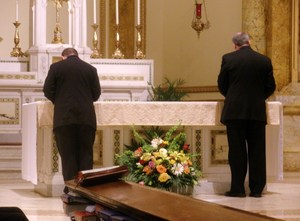 recognized in heaven by the laying on of hands and the prayer of the bishop, as priests. The mandate of the profession and the oath recognizes that these deacons are called to serve humanity enlightened by Christ as missionaries of Christ to the City and the world for the express purpose of growth and life in Christ. Further, taking the oath tells us that they no longer teach their own word but THE Word, Jesus Christ.
recognized in heaven by the laying on of hands and the prayer of the bishop, as priests. The mandate of the profession and the oath recognizes that these deacons are called to serve humanity enlightened by Christ as missionaries of Christ to the City and the world for the express purpose of growth and life in Christ. Further, taking the oath tells us that they no longer teach their own word but THE Word, Jesus Christ.
Acknowledged this evening is the life-long desire to conform life to Christ crucified and risen guided by the teaching of the Church.All this is 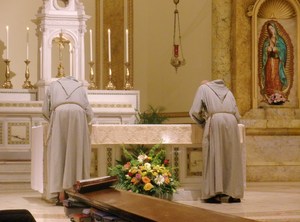 made possible by listening attentively to the Word of God and to tasting Him in the Eucharist, thus satisfying the sure yearnings of the human heart.
made possible by listening attentively to the Word of God and to tasting Him in the Eucharist, thus satisfying the sure yearnings of the human heart.
Here they begin to be more and more serious in preparing to make an account of the hope that they have known.
We are grateful for the photos taken by Esteban Sanchez, a second year theologian at Saint Joseph's Seminary.
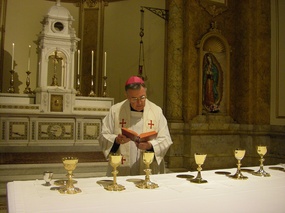
Today, following the last conference of our annual spiritual exercises, the Most Reverend Gerald T. Walsh, Rector of Saint Joseph's Seminary, consecrated seven patens and chalices of those to be ordained priests tomorrow. That today is also the feast of Saint Matthias, an apostle, what a great day to consecrate chalices and patens.
It is important to note that while a priest can be delegated to consecrate these sacred items used for divine worship, the bishop, standing in the place of Christ with the fullness of priesthood, is the visible sign of unity with the Roman Pontiff. Moreover, the bishop is the chief liturgist and administrator of the sacraments in the diocese with all ministry, whether presbyteral or diaconal, oriented toward him for the salvation of God's people. Hence, it is not merely a "nice" thing for the bishop to consecrate a priest's paten and chalice, it is essential that he do it (if not impeded by some serious event) because of the nature of what is being done: living the sacramentality given to us by Christ himself. Catholics do not presume to do things on their own but they live in communion with the bishop, in harmony and order.
According to preparatory note, this consecration is typically done by a bishop but may be delegated to a priest. The consecration may take place on any day. The following are prepared: holy chrism and whatever materials necessary for cleansing and wiping the chalice and paten as well as the bishop's hands. The chalice and paten should be placed on a table covered with a white-linen cloth or on the altar. It several chalices and patens are to be consecrated the bishop performs the anointings successively on each of them, but he says the orations only once and in the plural form. The bishop, standing and wearing the rochet, white stole, and gold-embroidered mitre, says:
Celebrant: Our
help is in the name of the Lord.
All: Who made heaven and earth.
C: Let us pray, my dear brethren, that by the help of God's grace this paten may be consecrated and hallowed for the purpose of breaking over the body of our Lord Jesus Christ, who suffered death on the cross for the salvation of us all.
Removing his mitre, says:
C: The Lord be
with you.
All: May He also be with you.
C: Let us pray.
Almighty everlasting God, who instituted the laws of sacrifice, and ordered among other things that the sprinkled wheaten flour should be carried to the altar on plates of gold and silver; be pleased to bless, hallow, + and consecrate this paten, destined for the administration of the Eucharist of Jesus Christ, your Son, who for our salvation and that of all mankind chose to immolate Himself on the gibbet of the cross to you, God the Father, with whom He lives and reigns, forever and ever.
All: Amen.
Having put the mitre on, the bishop dips the thumb of his right hand into the holy chrism, anoints the paten from rim to rim in the form of a cross, then rubs the holy chrism all over the upper side of the paten saying:

Lord God, may you deign to consecrate and to hallow this paten by this anointing and our blessing, + in Christ Jesus our Lord, who lives and reigns with you forever and ever.
All: Amen.
Then he proceeds to the blessing of the chalice saying:
Let us pray, my dear brethren, that our Lord and God, by His heavenly grace and inspiration, may hallow this chalice, about to be consecrated for use in His ministry, and that He may add the fullness of His divine favor to the consecration performed by us; through Christ our Lord.
All: Amen.
Removing his mitre, says:
C: The Lord be
with you.
All: May He also be with you.
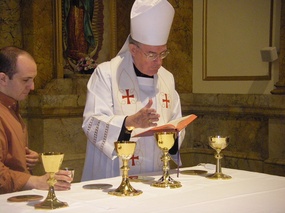
C: Let us pray.
O Lord our God, be pleased to bless + this chalice, made by your devout people for your holy service. Bestow that same blessing which you bestowed on the hallowed chalice of your servant, Melchisedech. And what we cannot make worthy of your altars by our craft and metals, do you nonetheless make worthy by your blessing; through Christ our Lord.
All: Amen.
With the mitre on, the bishop dips the thumb of his right hand into the holy chrism and anoints each chalice on the inside from rim to rim in the form of a cross saying:
Lord God, may it please you to consecrate and to hallow this chalice by this anointing and our blessing, + in Christ Jesus our Lord, who lives and reigns with you forever and ever.
All: Amen.
Removing his mitre, says:
C: The Lord be with you.
All: May He also
be with you.
C: Let us pray.
Almighty everlasting God, we beg you to impart to our hands the virtue of your blessing, so that by our blessing + this vessel and paten may be hallowed and become, by the grace of the Holy Spirit, a new sepulchre for the body and blood of our Lord Jesus Christ; through Christ our Lord.
All: Amen.
The hands are now cleansed.
This rite is taken from the Roman Pontifical of 1962. It was published in Philip T. Weller's 1964 The Roman Ritual: Complete Edition (the one volume). Thanks continuously goes to God for the fine work that Father Weller did for the Church is pulling together Roman Ritual in English.
Today, the Holy Father who is making a pilgrimage to the Shrine of Our Lady of Fatima (Portugal) made this consecration of for himself and all priests to the Blessed Mother, Mother of God, Mother of Priests, Mother of the Blessed Sacrament. The Pope's prayer is presented here for all priests to pray at the Mary Altar.
Immaculate Mother, in this place of grace, called together by the love of your Son Jesus
the Eternal High Priest, we, sons in the Son and his priests, consecrate ourselves to your maternal Heart, in order to carry out faithfully the Father's Will.

We are mindful that, without Jesus, we can do nothing good (cf. Jn 15:5) and that only through him,with him and in him, will we be instruments of salvation for the world.
Bride of the Holy Spirit, obtain for us the inestimable gift of transformation in Christ. Through the same power of the Spirit that overshadowed you, making you the Mother of the Savior, help us to bring Christ your Son to birth in ourselves too. May the Church be thus renewed by priests who are holy, priests transfigured by the grace of him who makes all things new.
Mother of Mercy, it was your Son Jesus who called us to become like him: light of the world and salt of the earth (cf. Mt 5:13-14).
Help us, through your powerful intercession, never to fall short of this sublime vocation, nor to give way to our selfishness, to the allurements of the world and to the wiles of the Evil One.
Preserve us with your purity, guard us with your humility and enfold us with your maternal love that is reflected in so many souls consecrated to you, who have become for us true spiritual mothers.
Mother of the Church, we priests want to be pastors who do not feed themselves but rather give themselves to God for their brethren, finding their happiness in this. Not only with words, but with our lives, we want to repeat humbly, day after day, our "here I am."
Guided by you, we want to be Apostles of Divine Mercy, glad to celebrate every day the Holy Sacrifice of the Altar and to offer to those who request it the sacrament of Reconciliation.
Advocate and Mediatrix of grace, you who are fully immersed in the one universal mediation of Christ, invoke upon us, from God, a heart completely renewed that loves God with all its strength and serves mankind as you did.
Repeat to the Lord your efficacious word: "They have no wine" (Jn 2:3), so that the Father and the Son will send upon us a new outpouring of the Holy Spirit. Full of wonder and gratitude at your continuing presence in our midst, in the name of all priests I too want to cry out: "Why is this granted me, that the mother of my Lord should come to me?" (Lk 1:43).
Our Mother for all time, do not tire of "visiting us", consoling us, sustaining us. Come to our aid and deliver us from every danger that threatens us. With this act of entrustment and consecration, we wish to welcome you more deeply, more radically, for ever and totally into our human and priestly lives.
Let your presence cause new blooms to burst forth in the desert of our loneliness, let it cause the sun to shine on our darkness, let it restore calm after the tempest, so that all mankind shall see the salvation of the Lord, who has the name and the face of Jesus,
who is reflected in our hearts, for ever united to yours!
Amen.

This coming Monday, May 17, the Church of St Catherine of Siena in Manhattan will host a lecture by Pierluigi Molla, the son of St Gianna Berretta Molla, as part of an evening of prayer for couples struggling with infertility.
Please join the physicians and staff of The Gianna Center for Women this Monday, May 17 at 6:30 pm for a special Mass, offered for the intentions of couples struggling with infertility and pregnancy-related miscarriages.
The Mass will be followed by a talk by Pierluigi Molla, the living son of St. Gianna Beretta Molla and an opportunity to view and venerate her relics.
Location: St. Catherine of Siena Church, 411 East 68th Street, NY (between 1st Ave and York)
Schedule of
Events
6:30 pm Mass, offered for the intentions of couples suffering from infertility, recurrent miscarriage and difficult pregnancies
7:30 pm Talk by Pierluigi Molla, son of St. Gianna
8:15 pm Blessing with St. Gianna's relics
8:30 pm Light reception and book signing
Physicians from
The Gianna Center in midtown Manhattan, which offers a highly effective,
ethically-sound approach to treating infertility, will also be present to
answer questions and offer support.
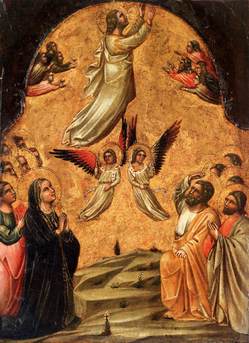
What is the consistent, clear teaching of the Church, that is, what has been taught down through the ages, about the Ascension of the Lord? What does it mean for the Lord to "ascend" to the right hand of God the Father? Does he actually go up into the heavens?
The Gospel of Luke tells us that Jesus blessed his disciples and then "parted from them and was taken up to heaven." And the Acts of the Apostles tells us that the disciples witnessed the Lord's ascension. So, the Scripture relate to us that Jesus' ascension was a public act which we too, follow according the Father's will.
Let me be crystal clear about the teaching: the ascension of the Lord is not only concerned with Christ's humanity; the ascension of the Lord is also about our humanity ascension to God's right hand in glory.
You will want to read--NO, you must read and re-read Credo for Today by Joseph Cardinal Ratzinger (Benedict XVI) pp 90-94. It is the best of the Church's contemporary theological reflections on this point of our faith.
Pope Saint Leo the Great (+461) taught, "Truly it was a great and indescribable source of rejoicing when, in the sight of the heavenly multitudes, the nature of our human race ascended over the dignity of all heavenly creatures, to pass the angelic orders and to be raised beyond the heights of archangels. In its ascension it did not stop at any other height until this same nature was received at the seat of the eternal Father, to be associated on the throne of the glory of that One to whose nature it was joined in the Son" (from a homily on 1 June 444).
And just a year later Saint Leo says, "This Faith, reinforced by the Ascension of the Lord and strengthened by the gift of the Holy Spirit, has not been terrified by chains, by prison, by exile, by hunger, by fire, by the mangling of wild beasts, nor by sharp suffering from the cruelty of persecutors. Throughout the world, not only men but also women, not just immature boys but also tender virgins, have struggled on behalf of this Faith even to the shedding of their blood. This Faith has cast out demons, driven away sicknesses, and raised the dead" (from a homily on 17 May 445).
In the Catechism of the Catholic Church we read, "This final stage stays
closely linked to the first, that is, to his descent from heaven in the
Incarnation. Only the one who 'came from the Father' can return to the Father:
Christ Jesus. 'No one has ascended into heaven but he who descended from
heaven, the Son of man.' Left to its own natural powers humanity does not have
access to the 'Father's house', to God's life and happiness. Only Christ can
open to man such access that we, his members, might have confidence that we too
shall go where he, our Head and our Source, has preceded us" (661).
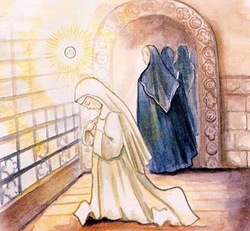 Lord Jesus Christ, you received into heaven Blessed
Imelda who loved you in the eucharistic banquet. By her prayers
may we learn to approach your holy table with that same
fervent love and so fulfill our longing to be with you, who live
and reign with the Holy Spirit, one God, for ever and ever.
Lord Jesus Christ, you received into heaven Blessed
Imelda who loved you in the eucharistic banquet. By her prayers
may we learn to approach your holy table with that same
fervent love and so fulfill our longing to be with you, who live
and reign with the Holy Spirit, one God, for ever and ever.Catholic League president Bill Donohue comments as follows:
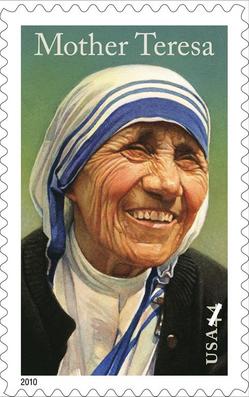
On August 26, the U.S. Postal Service is honoring the 100th anniversary of the birth of Mother Teresa. On February 2, I submitted an application to the Empire State Building Lighting Partners requesting that the tower lights feature blue and white, the colors of Mother Teresa's congregation, the Missionaries of Charity, on August 26. On May 5, the request was denied without explanation.
Mother Teresa received 124 awards, including the Nobel Peace Prize, the Presidential Medal of Freedom and the Congressional Medal of Freedom. She built hundreds of orphanages, hospitals, hospices, health clinics, homeless shelters, youth shelters and soup kitchens all over the world, and is revered in India for her work. She created the first hospice in Greenwich Village for AIDS patients. Not surprisingly, she was voted the most admired woman in the world three years in a row in the mid-1990s. But she is not good enough to be honored by the Empire State Building.
Last year the Empire State Building shone in red and yellow lights to honor the 60th anniversary of the Chinese Communist Revolution. Yet under its founder, Mao Zedong, the Communists killed 77 million people. In other words, the greatest mass murderer in history merited the same tribute being denied to Mother Teresa.
We are launching a nationwide petition drive protesting this indefensible decision (TO SIGN THE PETITION, Click here). We are petitioning Anthony Malkin, the owner of the Empire State Building, to reverse this decision.
To protest this decision, contact: lightingpartner@esbnyc.com
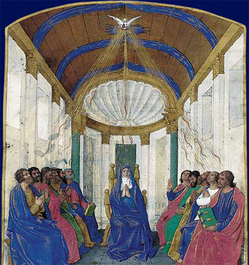
May is a month that is loved and its arrival is welcome for
several reasons. In our hemisphere spring advances with so many and colorful
blossoms; the climate is favorable for walks and excursions. For the liturgy,
May always belongs to the Easter Season, the season of the
"alleluia," of the revelation of the mystery of Christ in the light
of the Resurrection and of the Easter faith; and it is the time of expectation
of the Holy Spirit, who descends with power on the nascent Church at Pentecost.
With both these contexts, the "natural" and the liturgical, the
tradition of the Church is well in tune in dedicating the month of May to the
Virgin Mary. She is, in fact, the most beautiful flower to blossom in creation,
the "rose" that appeared in the fullness of time, when God, sending
his Son, gave the world a new spring. And she is at the same time humble and
discreet protagonist of the first steps of the Christian community: Mary is its
spiritual heart, because her very presence in the midst of the disciples is a
living memory of the Lord Jesus and pledge of the gift of his Spirit.
Pope Benedict XVI, Regina Caeli Address, 9 May 2010
Every time we get a new Supreme Court Justice nominee, I cringe because of the craziness that goes on at the confirmation hearings: it's not only about philosophical attachments but political mud-raking gets too personal at times. Nonetheless, I'm interested to see how the various ideologies of left and right are daily worked out and the interplay of the culture wars, which haven't changed all that much over the years: same ideas, different clothing. As always religion plays a role in our life: some commentators are too worried about the religious configuration of the US Supreme Court, and some seem not worried enough. Is there a middle ground? With the US President's choice of Elena Kagan as a Supreme Court candidate we realize that there's no Protestant on the bench but there are 6 Catholics of some type and 3 Jews, who also seem not to be too interested in practicing their faith. Exactly, what role does religion play today and are we approaching religion (the practice of faith) on its own terms, or are we reducing it to fit our image and likeness, our own warped standards? Have no fear, Monsignor Lorenzo Albacete helps to define our terms in this week's Il Sussidiario.
President Obama's nomination of Elena Kagan to be the next Supreme Court Justice has opened up a new front in the cultural battle that characterizes politics in the United States at the present time. Any observer can write the script of what the response to her nomination will be like. In fact, on this first day since the nomination the media has already defined the different ideological positions involved in the struggle, and unless something entirely unforeseen takes place, nothing new will be said between now and sometime in July when the Senate votes for or against the nomination.
If the nomination is approved, it will be the first time that there are no Protestants in the Supreme Court. There will be six Catholic Judges and three Jewish, including Kagan. It is difficult to imagine that many of the Catholic Senators will be influenced in their vote by their Catholic faith, and the Jewish Senators will almost be sure to insist that their judgment on the nomination has nothing to do with faith.
But what exactly is the Catholic view on how faith influences culture? The Christian claim is that faith is a way of knowing reality. Faith and knowledge of what is real cannot be separated.
This view of the relation between faith and knowledge has important consequences for our understanding of the relation between faith and culture, because the culture in which we live is built precisely on the separation between faith and knowledge of reality.
In his magnificent book Beyond Consolation, John Waters puts it this way:
"Our cultures, therefore, no longer affords us a way, in the
conventional public arena in which we spend so much of our time, of seeing
ourselves as we really are. Religion, the means by which we once achieved a
semantic accommodation with total reality, has been discredited by a pincer
movement between the reductions and abuses perpetuated in the name of religion,
and the opposing reaction from outside. One side claims the franchise for
redemption, the other victory over unreason... Stripped of their language of
absolute reality, our cultures begin to squeeze and oppress us in ways we are
incapable even of perceiving. What we have lost has been a loss to ourselves,
to our essential humanity, and yet we have been persuaded to read it as
liberation. We respond to invitations to celebrate our victory over traditions,
as though oblivious that we have half-sawn through the branch we are sitting
on...we have created for ourselves a culture that in many ways denies our
humanity."
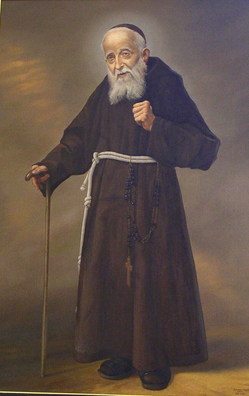 The Spirit of the Lord has been given to me, for he has anointed me. He has sent me to bring good news to the poor, to proclaim liberty to captives and to the blind new sight, to free the downtrodden, and to proclaim the Lord's year of favor.
The Spirit of the Lord has been given to me, for he has anointed me. He has sent me to bring good news to the poor, to proclaim liberty to captives and to the blind new sight, to free the downtrodden, and to proclaim the Lord's year of favor.
O God, perfect unity and highest good, You filled Saint Leopold, Your priest, with kindness and mercy for sinners, and an ardent desire for unity among all Christians; through his intercession, may we be renewed in spirit and heart and confidently work for the unity of all Christians in the bond of peace.
Read a brief biography of Saint Leopold Mandic

Archabbot Douglas R. Nowicki, O.S.B., 65, the eleventh Archabbot of Saint Vincent Archabbey, was re-elected as the major superior of the Benedictine community in Latrobe Pennsylvania on Tuesday, May 11.
In his role as the Archabbot of Saint Vincent Archabbey, Archabbot Douglas serves as the spiritual leader of the first monastery established in the United States and one of the largest monasteries in the world with nearly 175 monks. As archabbot, he is the chancellor of Saint Vincent College and Saint Vincent Seminary.
The Benedictines operate the Benedictine Military School in Savannah, Georgia, and the Penn State Campus Ministry Program at State College, Pennsylvania.
In addition to his responsibilities in this country, the Archabbot is also the spiritual leader of monasteries in Brazil and Taiwan.
May God grant Archabbot Douglas abundant blessings today and in the years ahead.
Saint Benedict, pray for us.
Saint Vincent de Paul, pray for us.
NB: Beg the Holy Spirit for graces upon the Benedictine abbeys of Saint Procopius and Marmion (both in the greater Chicago area) who will be electing new abbots this summer.
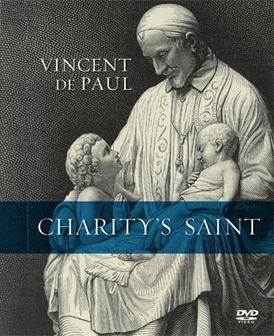 My primary education was with Vincentian Fathers in New Haven, CT. They were great men, hardworking, faithful and interesting. But the one thing missing was that they never spoke of Saint Vincent de Paul, their order's founder. More than 25 years later I lament this fact because I am now seeing a terrific richness and beauty of the man and saint, Vincent de Paul. A new video has been produced, "Vincent de Paul: Charity's Saint." It gives us a wonderful introduction into the heart of a man who has touched many facets of our life in the Church and in the US.
My primary education was with Vincentian Fathers in New Haven, CT. They were great men, hardworking, faithful and interesting. But the one thing missing was that they never spoke of Saint Vincent de Paul, their order's founder. More than 25 years later I lament this fact because I am now seeing a terrific richness and beauty of the man and saint, Vincent de Paul. A new video has been produced, "Vincent de Paul: Charity's Saint." It gives us a wonderful introduction into the heart of a man who has touched many facets of our life in the Church and in the US.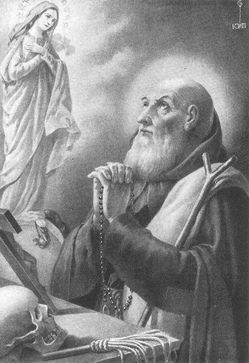 I will bless you and make your name great, so that you will be a blessing. I will bless those who bless you. And in you men shall find a blessing, Alleluia.
I will bless you and make your name great, so that you will be a blessing. I will bless those who bless you. And in you men shall find a blessing, Alleluia.
Lord God, You led Saint Ignatius along the way of humility, innocence, and fraternal charity to the heights of sanctity. Help us to imitate his virtues and to practice charity on earth in word and deed.
Read a brief biography on Saint Ignatius of Laconi

The fear of the Lord is holy, abiding for ever. The decrees of the Lord are truth and all of them just.
Eternal God, you blessed Saint Antoninus with a marvelous gift of counsel. By the help of his prayers while we walk in the darkness of this life, may we learn from a light of Christ all that we ought to do.
Saint Antoninus (1389-1459) was a Dominican friar was known for his evangelical zeal, holiness, the desire to live the Dominican life with integrity, the desire to attend to the poor, the reconciliation of sinners, and harmonious workings of society, both political and economic. He is the author of several books, including his own Summa theologica. His liturgical memorial is observed today even though on the Roman Maryrology the observance is noted for May 2.
From the Vita
He required of himself the most unflinching observance of the Rule of his Order, and never ate meat unless he were grievously ill. He slept upon the ground or upon bare boards. He always wore haircloth, and sometimes an iron girdle which bit into his naked skin. His virginity he kept ever undimmed by the last breath or shadow. He was so skillful in giving advice that he gained the common nickname of Antoninus the Counselor. At the same time so beautifully brilliant was his lowliness, that even when he was at the head of houses and provinces of his Order, he most cheerfully underook all the meanest services of the house where he was. Eugenius IV appointed him Archbishop of Florence, and he took it so ill, that it was only when awed by the threats of the Apostolic See that he obeyed, and accepted the dignity.
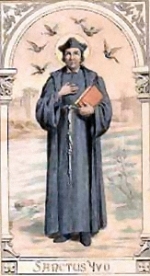 He who serves me, follows me, says the Lord; and where I am, my servant will also be.
He who serves me, follows me, says the Lord; and where I am, my servant will also be.
O God, You who chose Saint Ivo, Your priest, as a distinguished servant for the welfare of souls and as an advocate for the needs of the poor. Grant that we may imitate his charity and be protected in answer to his prayers.
Saint Ivo (Ives; 1253-1303) studied civil and canon law, Scripture and was known for his prudence, rectitude and the practice of charity. He joined the Franciscan Tertiaries (today known as the Secular Franciscan Order). In time he was ordained to the minor orders and then to the priesthood. Ivo's good and holy preaching was well known among the people of Brittany leading others to change their lives to adhere to Christ more closely. In the service of the bishop he worked to prevent the state's encroachment on the Church and he made sure the poor's needs were met. Tradition has Saint Ivo as a patron of lawyers but not their model as exemplied in a translation of a Latin phrase: Saint Ivo was a Breton, a lawyer and not a thief, a marvelous thing for the people.
 Yesterday morning (May 8) my friend Gabriel Scasino was invested in the habit of the Order of Friars Minor Conventual (OFMConv) at Saint Bonaventure Friary (Forestville, MD) during Lauds. His Minister Provincial, Father Justin Blase, presided at Lauds, blessed the habit, and then invested Gabriel with the Habit. Father Justin then celebrated the Holy Sacrifice of the Mass. Friar Gabriel belongs to the Immaculate Conception Province.
Yesterday morning (May 8) my friend Gabriel Scasino was invested in the habit of the Order of Friars Minor Conventual (OFMConv) at Saint Bonaventure Friary (Forestville, MD) during Lauds. His Minister Provincial, Father Justin Blase, presided at Lauds, blessed the habit, and then invested Gabriel with the Habit. Father Justin then celebrated the Holy Sacrifice of the Mass. Friar Gabriel belongs to the Immaculate Conception Province.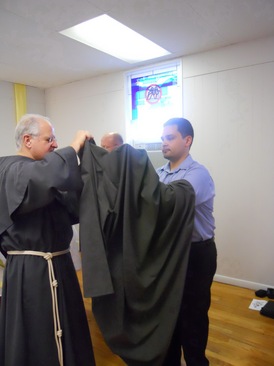
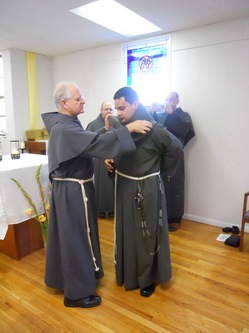
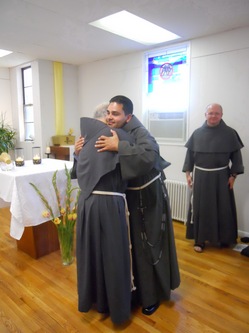
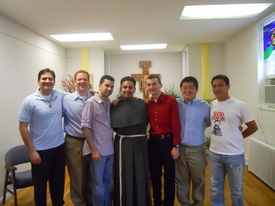
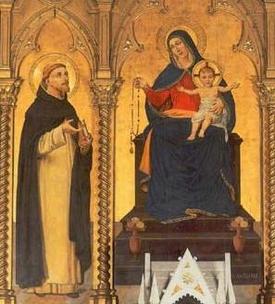 Virgin Mother Mary, with trust we approach you. We, your preachers, fly to you who believed in the words sent from heaven and pondered them in your heart. We stand close around you, who are always present to the gathering of apostles.
Virgin Mother Mary, with trust we approach you. We, your preachers, fly to you who believed in the words sent from heaven and pondered them in your heart. We stand close around you, who are always present to the gathering of apostles.
In you the Word was made flesh, that same Word which we receive, contemplate, praise together and preach. Therefore, under your guidance we today devote ourselves anew to the ministry of the Word. Furthermore, we declare to you that, hearing with you the Word within ourselves and anointed by the Spirit whose sacred vessel you pre-eminently are, we are consecrated in the name of Jesus Christ to the evangelization of the world.
With the eyes of your heart enlightened, you understood the mystery of the Word. Through you we, too, are able to perceive the presence of that same Word in the history of our time, so that we may finally contemplate him face to face.
Through you the Father sent his Son into that world that he might save it. Through you we will be powerful in the sight of your people, becoming witnesses of that truth which frees and of that love that unites.
To this place we have brought our needs and here we ponder them. Do you, Mother, give us strength and perserve the harmony of our family, so that what was begun by our profession may be brought to completion by our love for one another, for the salvation of the world and to the praise and glory of God.
Today the Dominican family (the friars, second order nuns and third order sisters) re-dedicated themselves to the Blessed Virgina Mary, who with Saint Dominic, is a patron of the Order of Preachers (the Dominincans).
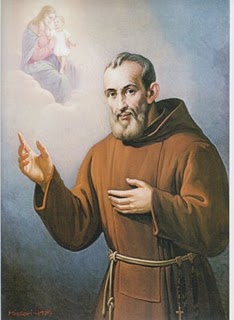 The Son of Man himself did not come to be served but to serve, and to give his life as a ransom for many.
The Son of Man himself did not come to be served but to serve, and to give his life as a ransom for many.
Merciful God, You gave Brother Jeremiah of Wallachia the grace of imitating Your Son in serving his brothers and giving himself unconditionally in service for them. Help us to follow the evangelical way of humility and love, so that we may cooperate more fully in Your universal plan of salvation.
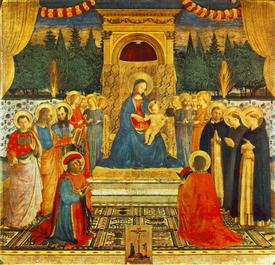 Blessed are you, O Virgin Mary, for you came the salvation of the world. Already glorious, you rejoice before the Lord. Intercede for us with your Son. Alleluia!
Blessed are you, O Virgin Mary, for you came the salvation of the world. Already glorious, you rejoice before the Lord. Intercede for us with your Son. Alleluia!
Faithful God, our Father Dominic founded the Order of Preachers under the special patronage of the Blessed Virign Mary. May her prayers continue to support us that we may rejoice in the glory you promise.
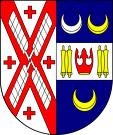 New priests will be ordained for the Archdiocese of New York and the Franciscan Friars of the Renewal, these are their stories... Our New Priests (CNY article).pdf
New priests will be ordained for the Archdiocese of New York and the Franciscan Friars of the Renewal, these are their stories... Our New Priests (CNY article).pdf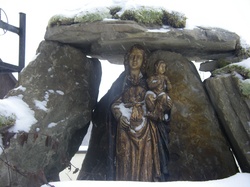
Back in February I received two extraordinary gifts from Brother John Paul,
The nuns in Livingston Manor, New York, call themselves officially, "The Monastic Family of Bethlehem and of the Assumption of the Virgin" founded on November 1, 1950, at Saint Peter's Square in Rome when Pope Pius XII proclaimed the dogma of the Assumption of the Blessed Virgin Mary. The inspiration of French pilgrims was described in this way:
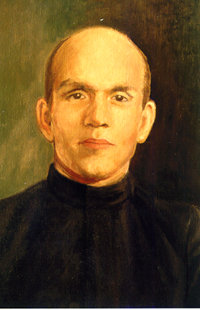
Gregory Frackowiak was the youngest of our four martyrs was 31 when he was beheaded on May 5, 1943, in the prison of Dresden. Brother Gregory consciously offered his life as a substitute for others [does this sound the Law of the Gift spoken of my Jesus and recalled often by Pope John Paul II?]. His willingness to claim responsibility for some thing he did not do saved several people (including his brother) from certain imprisonment and death. This heroic gesture makes him similar to another martyr of the same war -- St. Maximilian Kolbe, who also gave his life for someone else in the concentration camp at Auschwitz.
Gregory is his religious name. He was born Boleslaw Frackowiak in Lowecice (a small village not far from Poznan). One of twelve children, he grew up in a deeply religious atmosphere. At the age of 18 he entered the Society of the Divine Word (SVD) novitiate in Gorna Grupa. From the beginning he exhibited great joy in being a missionary Brother. He worked both as a receptionist and as a professional binder in the printing press. Among the people of the area he was remembered as someone with a special sensitivity towards the poor. He had numerous visitors, because he was known for providing something to eat, a warm welcome, and a good word for everyone. Some called him "the friend of the poor."
His gentleness, simplicity, and deep spirituality were also appreciated by the students of the minor seminary, who enjoyed his presence and sought his advice. His work as a bookbinder in the printing press was acknowledged as exemplary by both lay employees and by the confreres. When Brother Gregory professed his final vows on September 8, 1938, he was deeply convinced that he was offering his life to God for the mission of Christ and of the Church. He had no idea how quickly and how radically he would be expected to live out that commitment.
When World War II began, Brother Gregory was part of the SVD community in Gorna Grupa. When this house was made an internment camp for priests, the brothers were forced to leave. For a while he lived with relatives in Poznan. There he served as the sacristan at St. Martin's Parish. He also taught catechism to children and even baptized some of the newborn. One day the pastor was arrested by the Gestapo. Since he could no longer safely hide the Blessed Sacrament, Brother Gregory took upon himself the task of distributing it among the faithful. For an entire day and night he and others in the parish knelt in adoration before the Blessed Sacrament. Then with great reverence he distributed Holy Communion to those present.
Eventually Brother Gregory was able to find work in a printing press at Jarocin, a small town not far from his home. Like many others, he received and passed on some anti-Nazi material. However, Fr. Paul Kiczka, SVD, advised him to discontinue receiving and passing on these pamphlets, and so he stopped. A year later these activities were discovered by the Gestapo.
Among those arrested were men who had wives and children. Wouldn't the others be saved if he took on himself the whole responsibility for this anti-Nazi activity? "May I accept the responsibility for them?" he asked his spiritual director. Fr. Kiczka responded: "If you have the courage and strength. It would mean sacrificing your life." Gregory made his confession and received Holy Communion. After his thanksgiving he shook his confrere's hand and said, "Till we meet again -- but not on this earth." He went home, where he was arrested the following day. He "confessed" his crime, and immediately afterwards some of the other suspects were freed. Gregory was transferred from the prison in Jarocin to Poznan and then finally to Dresden, where he was beheaded.
A few hours before his death Gregory wrote to his relatives. A few sentences from that letter reveal his readiness for death: "I am writing to you for the last time in this world. By the time you receive this letter I will no longer be among the living. Today on Wednesday (5.5.1943) at 6:15 PM I will be executed. Please pray for me. It is already one o'clock, and at two o'clock the priest will bring me Jesus. Don't cry, but pray for my soul. I leave it to you, whether you want to communicate to my mother the manner of my death. I am completely at peace. I greet all of you, and I will wait for you in God's presence. Please greet all the Missionary Brothers in Bruczkow. After the war bring my cassock there. God bless you. Remain faithful Catholics. Forgive any faults of mine. I'm sorry for my poor mother. May God protect you. Till we see each other in heaven."
Blessed Gregory Frackowiak was beatified by Pope John Paul II on June 13, 1999, together with three companions from the Society of the Divine Word, as part of a group of 107 Polish martyrs of the Second World War.
This biography provided by the Society of the Divine Word, this religious congregation out if you think you have a vocation. We need more Blessed Gregorys....
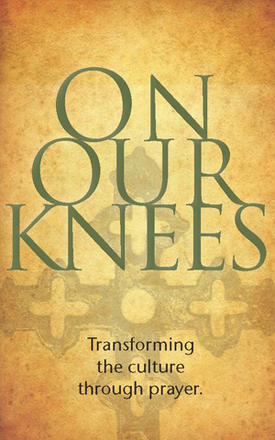
Yesterday, May 3rd, marked the 10th Anniversary of the entrance into eternal life of John Cardinal O'Connor.
Many of you were able to be present -and others were present through EWTN--and shared prayer with us for the Cardinal's eternal peace and God's mercy. In case you want see the video coverage, you may watch it here and I suspect that EWTN will run the program again.
At the end of the Mass, Archbishop Timothy Dolan launched and introduced a new effort of the Knights of Columbus and the Sisters of Life called the National Prayer for Life Campaign.
Please join us in praying this prayer every day and give it to others; all of us are hoping that it spreads throughout our nation so that a Culture of Life may be fully restored!
On the old liturgical calendar today we find the feast of the Discovery of the True Cross by Saint Helena. A few years ago I had the privilege of spending a month at the Abbey of the Holy Cross in Jerusalem in Rome where the relics of the True Cross and Passion are preserved. How beautiful and holy it was to be a part of a worshipping community that had the presence of such items connected with the oblation of Our Lord and Savior! Every day I spent time in prayer in the chapel holding the these relics. So, that the revised liturgical calendar deleted this feast is a sad state of affairs. It is, after all, the cross of Christ that gives new life! As part of the rites for the day we find the Blessed of Crosses.
P: Our help is in the name of the Lord.
All: Who made heaven and earth.
P: The Lord be with you.
All: And with your spirit.
Let us pray.
Almighty everlasting God, merciful Father and our unalloyed comfort, in virtue of the bitter suffering that your only- begotten Son, our Lord Jesus Christ, endured for us sinners on the wood of the cross, bless + these crosses which your faithful will set up in their vineyards, gardens, fields, and other places. Shield the land where they are placed from hail, tornado, storm, and every onslaught of the enemy, so that the produce, ripened for the harvest, may be gathered to your honor by those who put their trust in the holy cross of our Lord Jesus Christ, your Son, who lives and reigns with you forever and ever.
All: Amen.
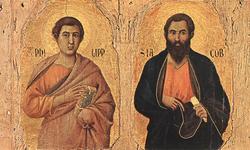
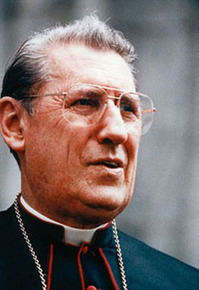 Today, we also remember the soul of John Joseph Cardinal O'Connor, PhD, archbishop of New York, 1984-2000. He died 10 years ago today.
Today, we also remember the soul of John Joseph Cardinal O'Connor, PhD, archbishop of New York, 1984-2000. He died 10 years ago today. The practice of adorning the Blessed Mother's statue
or icon developed as a pious custom of the people in their familiar
surroundings. By the sixteenth century the coronation images of the Blessed
Virgin Mary became widespread. While it is not as prevalent today, a ceremony of crowning of Mary continues to be a sincere yet profound spiritual and human gesture on the part of the faithful in front of Mary's beauty.
The practice of adorning the Blessed Mother's statue
or icon developed as a pious custom of the people in their familiar
surroundings. By the sixteenth century the coronation images of the Blessed
Virgin Mary became widespread. While it is not as prevalent today, a ceremony of crowning of Mary continues to be a sincere yet profound spiritual and human gesture on the part of the faithful in front of Mary's beauty.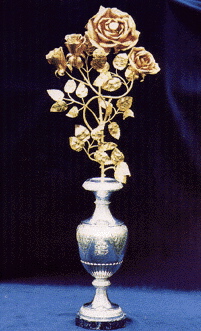
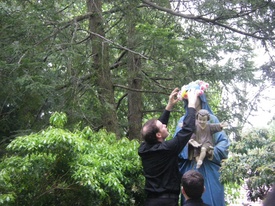
Archbishop Dolan & Br Ignatius Perkins honored at St Catherine of Siena Priory (NYC) healthcare Mass
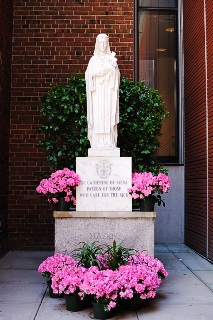 The other day I mentioned the 4th annual Mass and award for healthcare professionals who treat the sick and the dying with dignity at Saint Catherine of Siena Priory & Church (East 68th St, NYC) suggesting prayerful solidarity and physical presence, if possible. I had hoped to go myself, but too many things to do at the seminary in the final week of classes prevented me.
The other day I mentioned the 4th annual Mass and award for healthcare professionals who treat the sick and the dying with dignity at Saint Catherine of Siena Priory & Church (East 68th St, NYC) suggesting prayerful solidarity and physical presence, if possible. I had hoped to go myself, but too many things to do at the seminary in the final week of classes prevented me.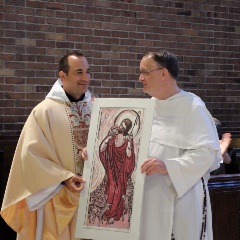

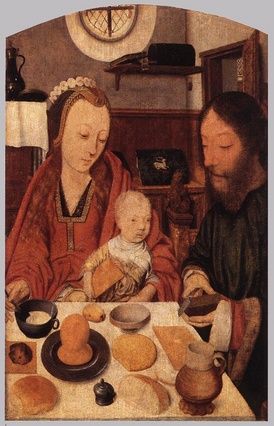 God, creator of the world, placed man upon the earth to till it and to keep it, alleluia.
God, creator of the world, placed man upon the earth to till it and to keep it, alleluia.
Pope Benedict asks that we pray specifically for these intentions during the month of May. Recall what Saint Augustine called prayer: the soul's affectionate quest for God. May our prayer be just that: affectionate and a sincere search for a relationship with our loving heavenly Father.
The general intention
That the shameful and monstrous trafficking in human beings, which sadly involves millions of women and children, may stop.
The missionary intention
That priests, religious women and men, and lay people involved in
apostolic work may understand how to bring missionary enthusiasm to the
communities they serve
